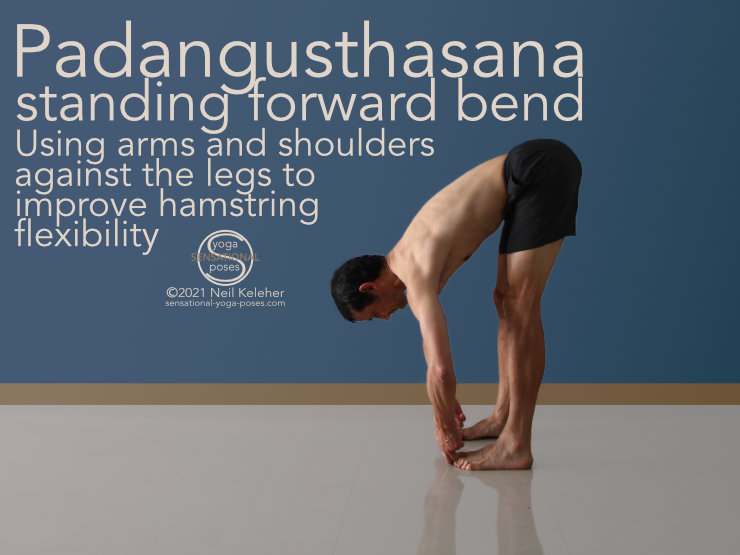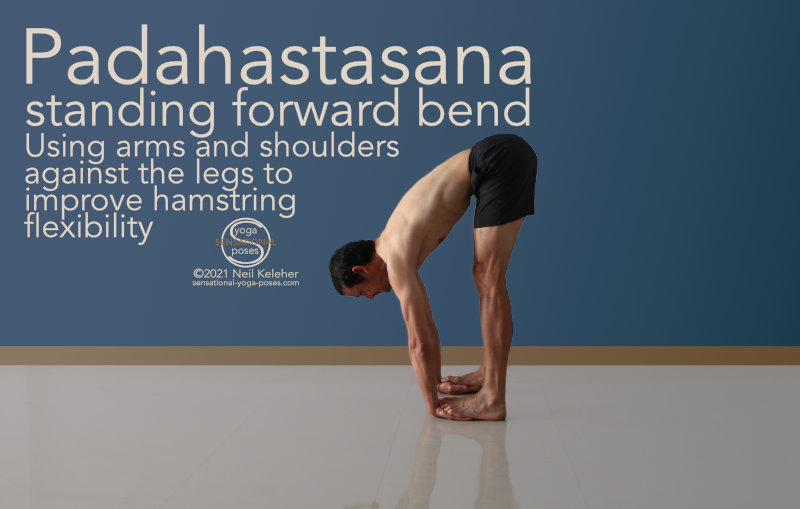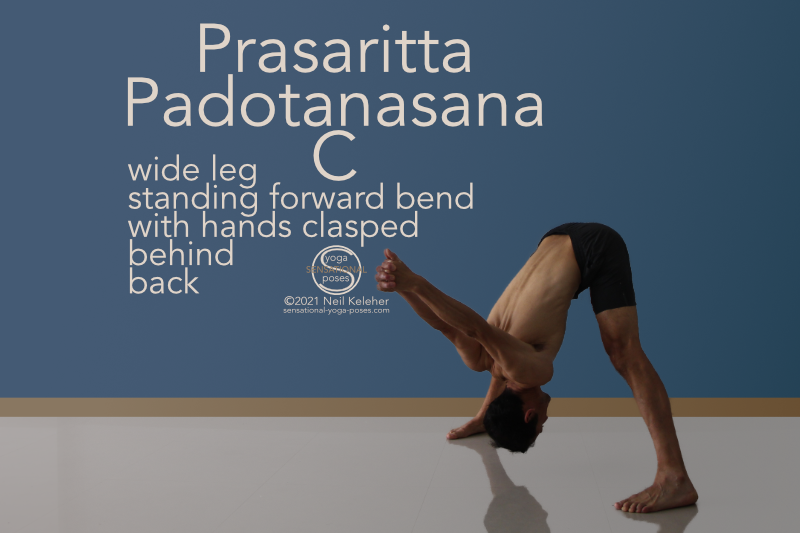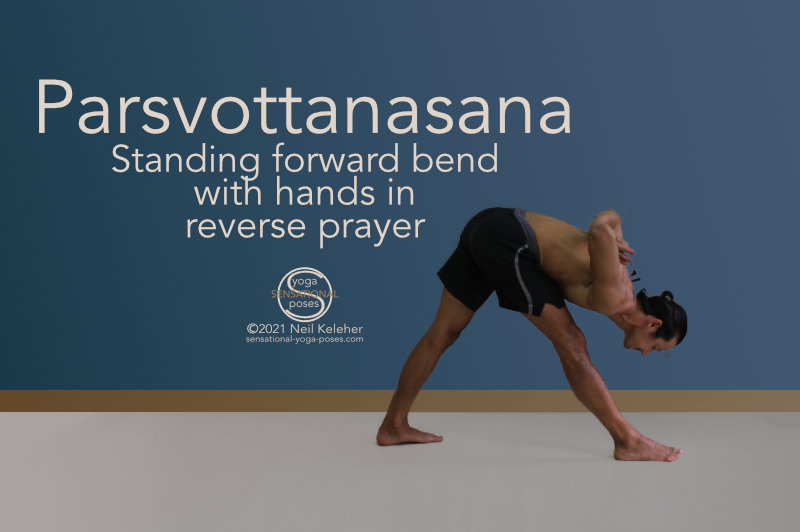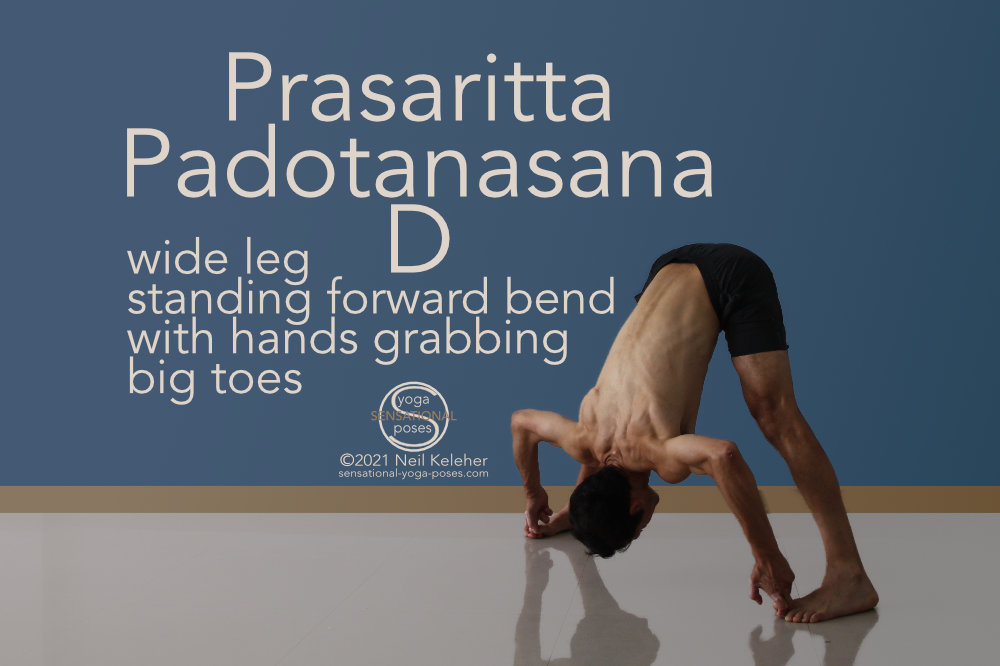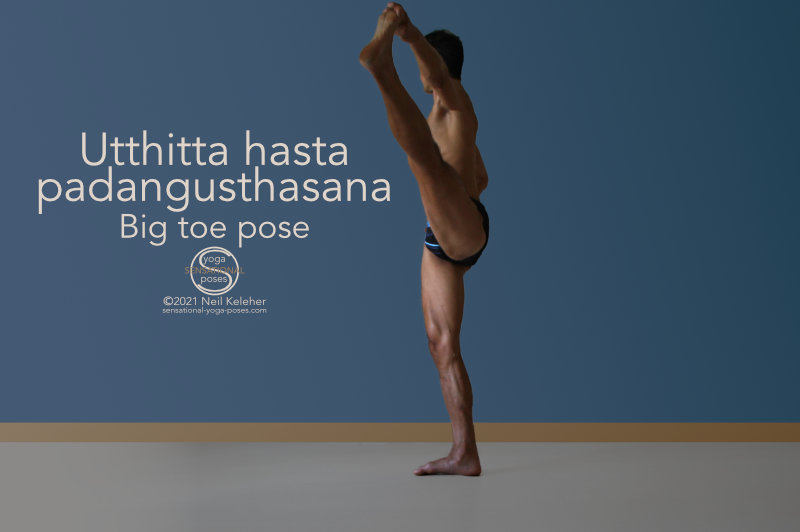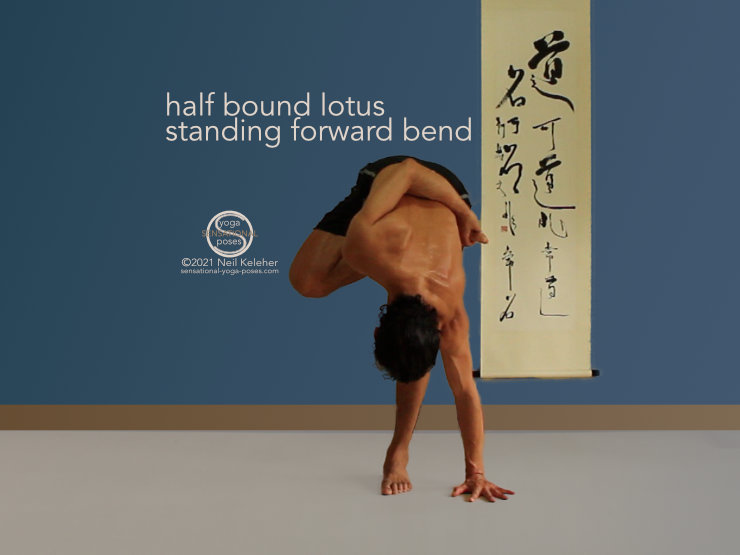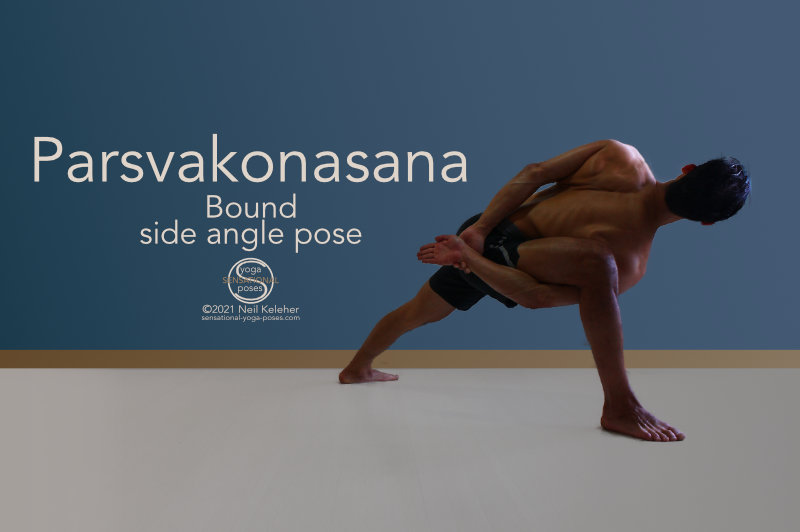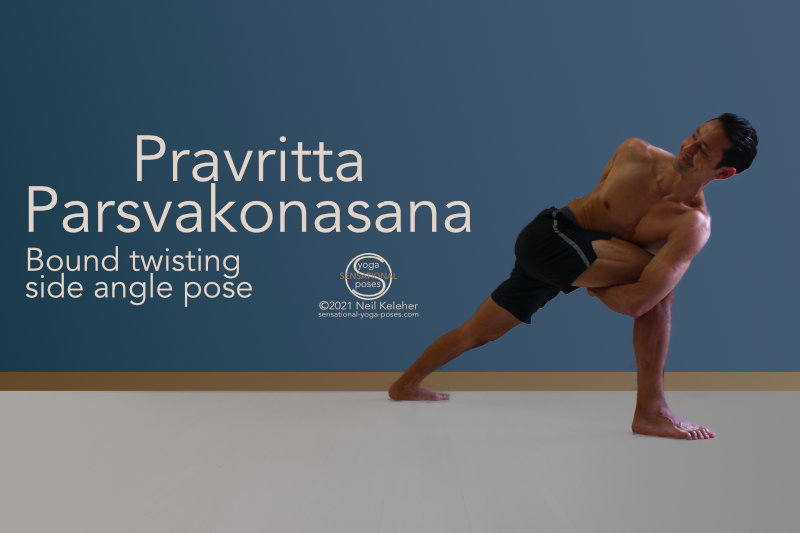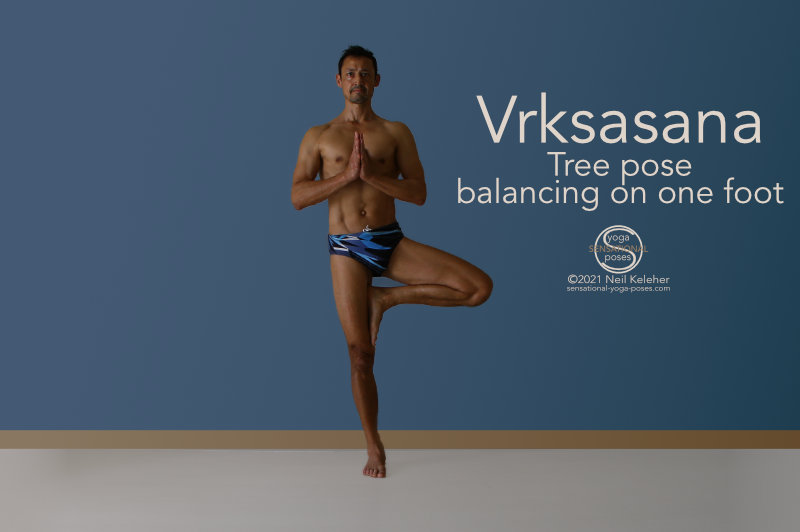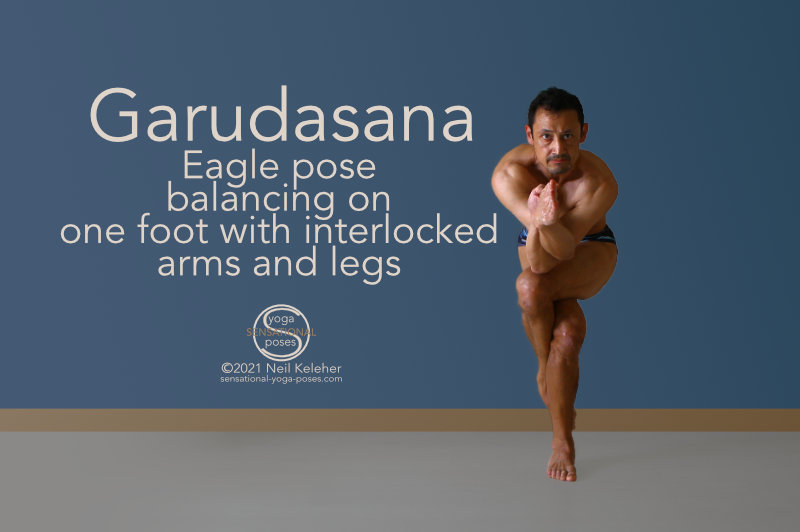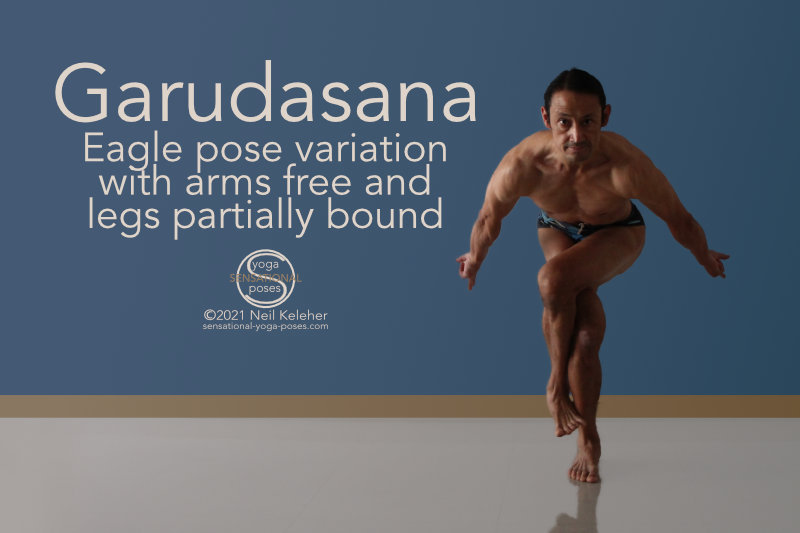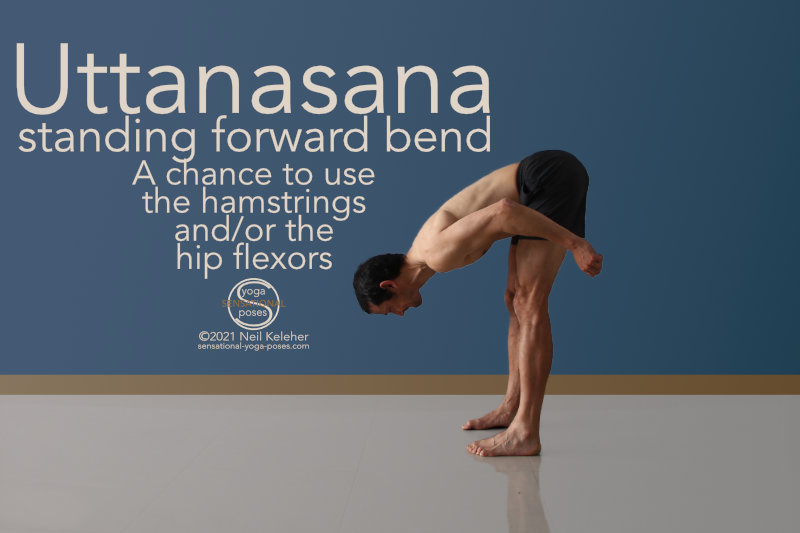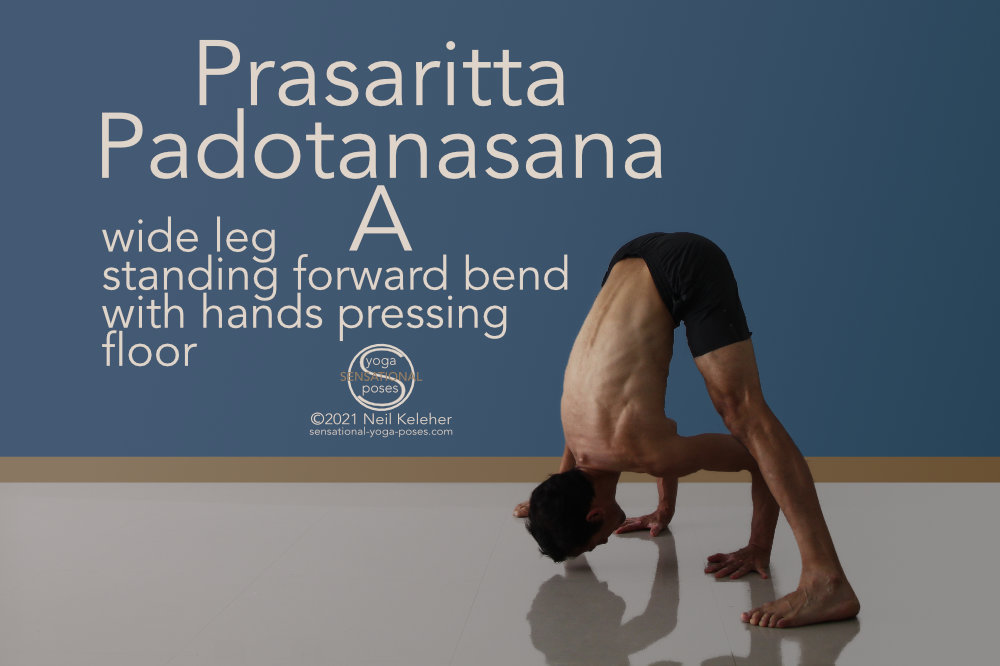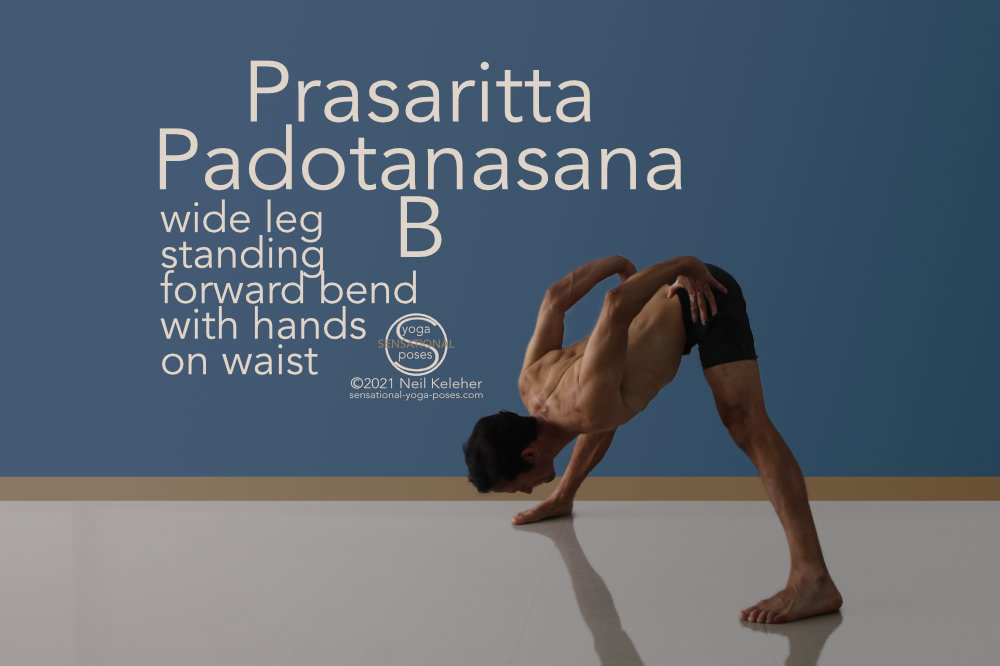Lets talk about binding poses
Now before going on it might be helpful to talk about binding poses. There's a whole section in this website devoted to the idea of binding poses, but some of that is old, and while still valid, it can be helpful to talk about binding from a fresh perspective, particularly since these days I actually don't do much in the way of binding poses, though I am starting to explore them again.
What are binding poses?
With binding poses you grab onto the toes or put your hands under your feet as in padangusthasana or padahastasana.
Or you grab your hands behind your back as in prasaritta padotanasa C.
Or you put your hands in prayer behind your back as in parsvotanasana (reverse prayer).
Other binding poses include prasaritta padotanasana d, where you again grab the big toes, as you do also do in utthita padangusthasana.
If you grab your big toe from behind your back while in lotus, that's a bind.
In other binding poses you grab the opposite wrist (or hand) behind the back (while wrapping around a leg), as in poses like side angle and twisting side angle (the binding versions).
The key point in all of these is that one part of the body either grabs or presses against another part. So I'd count tree pose as a bind even though you aren't grabbing anything because the foot can actively press against the thigh.
And likewise eagle (even if you don't have the legs fully bound).
Note that this way of categorizing binding poses isn't so much based on the look of the pose or its "external appearance". Instead it's based on the general effect that results from externally pushing or pulling one body part against another.
Binding changes the feel of a pose
When you pull or push on one part of the body with another part of the body, it changes the actual feel of the pose. And here when I refer to feel, I mean the feel of muscles activating and the feel of connective tissue tension.
Since muscle activation causes an associated force, and connective tissue tension transmits that force, then binding poses change the way your muscles work within that pose (versus a pose that is similiar in shape but without the bind.)
Whether you are pulling against a body part of pushing against it, this has a noticeably different affect than not pulling or pushing against a body part.
We can use this understanding when analyzing binding forward bending poses like padangusthasana and padahastasana (as well as prasaritta padottanasana A and D). We can then look at how to apply this understanding to standing forward bending poses like uttanasana where we have the option of not binding.
A closer look at padangusthasana
In padangusthasana, with knees straight and grabbing the big toes, and forgetting all about the vinyasas (i.e. the part where you inhale and straighten your arms and then exhale and move deeper into the forward bend, where you then hold the position for five breaths), you can use your arms against your big toes (and against your feet) in a couple of ways.
Options for how to use your arms in padangusthasana
One way to use your arms is to pull them forwards, as if trying to pull your big toes out of your feet. Your toes will resist and what you may find is that your butt and your hamstrings activate. (Your big toes and the muscles of your foot will also engage). While your arms work to pulls your toes forwards, your butt and hamstrings activate to resist that pull.
The interesting thing is, you may find that even with your hamstrings and butt active, you can deepen the forward bend.
The point to understand here is that muscles, when active, can shorten, lengthen or remain the same length. The import is that you can stretch muscles while they are active.
Another option is to use your arms as if trying to pull upwards on your big toes. Of course your foot and toe muscles will resist. The upward pull exerted on your toes by your arms causes a downwards pull on your ribcage. And what you may find is that your butt and hamstrings activate to help resist this downwards pull.
And so what you end up with is a loop of muscle generated tension. In the midst of all this tension, you can vary or change the length of the muscles involved. Increase elbow bend, and/or pull your shoulders towards your hips, and you can increase the forward bend of your hips. Thus you can use elbow and shoulder muscles to help lengthen the muscles at the back of your hips.
All the muscles involved will generate "feel" or "sensation" because they are active.
How to avoid lower back stress in standing forward bends
With forward bends, there can be a lot of stress on the lower back. One answer to this is to adjust the bend of your lower back. You can try bending it back or forwards, or straighten it. Use the position that feels best.
Another option is to brace the lumbar spine and hip bones laterally using the quadratus lumborum and lumbar/sacral spinal erectors.
Yet another option (that may or may not relate to bracing the lumbar spine laterally) is to pull your belly in using your transverse abdominis.
Before going on about how or why activating the transverse abdominis can help, one other option that can happen automatically when you use your arms against your legs is to stablize the hip joints, and thus, the hip bones. If, when using your arms, your hip muscles activate but you find that you have lower back pain, you can try moving your sitting bones upwards or downwards to change the curve in your lower back. Another option is to try to spread or retract your sitting bones a slight amount.
As to why activating your transverse abdominis may help support your lower back when doing forward bends?
Why using the transverse abdominis can help support your lower back and SI joints when doing standing forward bends
Portions of the aponeurosis, or tendon, of the transverse abdominis pass in front of the spinal erectors before attaching to the lumbar vertebrae. Other portions pass behind the spinal erectors. The two layers thus contribute to the sheath that surrounds the spinal erectors in the lumbar region. (The technical term for this sheath is the paraspinalis rectinacular sheath. It's modeled as a part of the thoracolumbar fascia.)
The portion of the transverse abdominis that attaches directly to the lumbar spine (whilst wrapping around the spinal erectors in the process) could be labelled as the middle band or the transverse abdominis.
The lower band of the transverse abdominis covers the front "opening" of the pelvis. It attaches to the inguinal ligament and the ASICs, and when active, it tends to pull inwards on the asics which in turn levers the back of the hip bones, the portion that project behind the sacrum, outwards. Behind the sacrum, the sheath that covers the spinal erectors fuses with the aponeurosis (tendon) of the spinal erectors forming a mass of connective tissue called the thoracolumbar composite.
So activating the lower transverse abdominis adds tension to this thoracolumbar composite which anchors the bottom of the spinal erectors (and incidentally, the lumbar multifidus are also anchored by this action since they too attach to the spinal erector aponeurosis). Activation of the middle and upper transverse abdominis can tension the sheath of the spinal erectors and that may help to reduce support the lower back and also magnify the effectiveness of the spinal erectors, even though they are lengthened.
That's the theory anyway. What's more important is putting it into practice to see if it works or not. To that end, you can pull your transverse abdominis in (or learn how) and notice whether it makes your lower back feel better or not while doing a standing forward bend. If focusing on the lower band of the transverse abdominis, you can try slightly spreading your sitting bones while lifting them or slightly retracting them while pulling them down. If focusing on the upper band, you can try changing the front/back bend of your ribcage and thoracic spine to see if that helps.
Arm actions you can use when doing padahastasana
In padahastasana, because your hands are under your feet with the palms up and fingers pointing rearwards, you can press all your toes down against your wrists. And you can press your forefeet down also. As with pagangusthasana, you can either pull your hands forwards, as if trying to pull your hands out from under your feet (but resisting with sufficient downwards pressure of your feet) or pull upwards with your hands.
In all cases the idea is to use your arm muscles against your legs so that your leg muscles, particularly those at the back of the legs, engage.
Another option for both poses is to try a mix of both, pulling (or vectoring) your arms forwards and up.
In either case, the response should be sustained activation of your glutes and hamstrings (as well as muscles of your arms and torso.)
It you only get one or the other activating (only the hamstrings or only the glutes), something you could try is to deliberately activate your glutes and hamstrings.
The basics of muscle activation and resisting joint compression
If you managed to stay awake in science class, you may remember that forces work in opposing pairs. A force can only exist in the presence of an equal and opposite force. Since muscles are force generators, they create force when active. In addition, in order to activate, they need an opposing force to work against.
So, to use your arms in a forward bend, they have to work against something. That something is the force produced by active hamstrings and glutes.
While muscles are active, they can either shorten, lengthen or remain the same length.
In poses like padangusthasana and padahastasana where you can use your arm muscles against your hamstrings and glutes, you have the option of keeping the muscles the same length, in which case you stay still in the pose.
You also have the option of shortening one set of muscles, say the active arm and shoulder muscles, so the hamstrings and glutes lengthen. You thus stretch these muscles while they are active. The more you lengthen them (with a corresponding shortening of whatever arm and shoulder muscles are working), the more you stretch them.
Something else to consider is your joints.
What happens to skeletal joints when they are under load?
Pulling yourself into a forward bend with the use of your arms, your hamstrings (as well as your glutes) are, ideally, active. What this means is that your knee joints, (and your hips and your ankles) are under a lot of compressive force.) Likewise your elbows and shoulders.
The same muscle activation that drives movement (or if you aren't moving, that drives "stabilization") also adds tension to the joint capsules, tensioning them so that synovial fluid is pressurized. This in turn helps to maintain space within the joint, preventing articulating surfaces from rubbing. Another way to think of this is that it hydrostatically lubricates the joints. And that in turn means that the joint can act like a frictionless pulley. The joint then allows tension to be evenly distributed on both sides of the joint.
The point here is that active muscles keep joints "lubricated" and in turn, lubricated joints allow muscles to share load.
What muscles need in order to activate and relax
In order to control muscles effectively, and this is in addition to an opposing force to work against, it helps to have one end of a muscle act as a reference and as an anchor. So for example, at their lower end the hamstrings attach to the lower leg bones. But in turn, one of the calf muscles, the gastrocnemius, has tendons that lace between the hamstring tendons before attaching to the femur. Activation of this calf muscle is one way of anchoring the hamstrings at their base.
And so in either of the two above poses, you can try to deliberately activate your calve muscles, or accentuate the activation, to see if you get better hamstring (and glute) activation as a result.
The biceps femoris is the outer hamstring muscle and it attaches to the fibula. This muscle may require further anchoring via a downwards pull on the fibula. You can do that by activating the peroneus longus and brevis. And a simple way to do that is to activate the feet and ankles.
One of the advantages of both padangusthasana and padahastasana is that when you pull up against your big toes and or your feet, your foot muscles activate to stiffen and resist this pulling force. In addition, because your feet are bearing the weight of your body, the feet and lower leg bones can then act as anchors for any muscles that cross the knee joint.
This then makes it easier to control muscles like the hamstrings and gluteus maximus (which attaches to the lower leg bones via the IT band)because their lower end is anchored.
The trick is then applying this understanding to standing forward bends where we aren't binding, whether by choice or simply because we can't. But, before going on to that, there is a simple way to simulate binding when doing a standing forward bend.
Simulating a bound standing forward bend.
If you can't reach your big toes (which means you won't be able to slide your hands under your feet either, at least not with your knees straight) an option is to stand in the center of your mat facing the long edge.
You can then grab the sides of the mat. Here you can simulate the suggested arm actions from padangusthasana and padahastasana by either pulling forwards on the mat or pulling upwards, or pulling forwards and upwards.
Applying an understanding of binding to non-binding standing forward bends
In padangusthasana and padahastasana, the idea espoused in this article is to use the arm and shoulder muscles against the muscles at the back of the legs to increase the forward bend at the hips.
An option is to use the muscles at the front of the legs and hips, the hip flexors against the muscles at the back of the legs. So, you can use your quadriceps (particularly the vastus muscles) and the hip flexors against the glutes and hamstrings.
I'd suggest here that possibly one of the biggest challenges when working on flexibility is anchoring muscles effectively. With binding, the anchoring is almost built in. If you pull up on your big toe in padangusthasana, your big toe activates and resists.
Anchoring the hip flexors (so you can use them effectively)
How do you anchor the bottom end of the hip flexors. In this case I'm talking about hip flexors like the sartorius, tensor fascia latae and rectus femoris, all of which work on the knee as well as the hip.
Here the salient point is understanding that the knees rotate and the long hip flexors (the sartorius, gracilis and tensor fascai latae) help control that rotation.
In addition, while standing, the shin can rotate, or have the appearance of rotating, relative to the feet.
I say "the appearance of rotating" because it may not be classed as a "pure rotation". Instead it's a combination of tilting and rotating.
In any case, if you want to use your hamstrings and hip flexors effectively, it can help to stabilize your feet and shins against rotation.
One simple way to achieve this is to press your toes down strongly into the floor. Another option is to "stiffen" your heels and ankles.
With your shins stabilized against rotation from below, you can then work at using your hip flexors against your hamstrings to increase your forward bend.
And actually, even if you are doing padangusthasana or padahastasana, you can do the same thing. You can rest your arms and use your hip flexors. Then, you can rest your hip flexors and use your arms.
Using Your Hip Flexors in the Prasaritta Padotanasana Poses
If you do the four prasaritta padotanasana variations that are found in the Ashtanga system, you can experiment with using your hip flexors for the B and C verstions where your hands are on your waist or clasped behind your back. For A and D, you can work at using arms against your legs. (For A in particular, you can press your hands forwards and your feet backwards or vice versa.)
For more on how to stabilize against rotation, and how to activate hamstrings, hips flexors and glutes, check out these muscle control programs.
They are designed to make it as easy as possible for your to activate these muscles and feel them.
